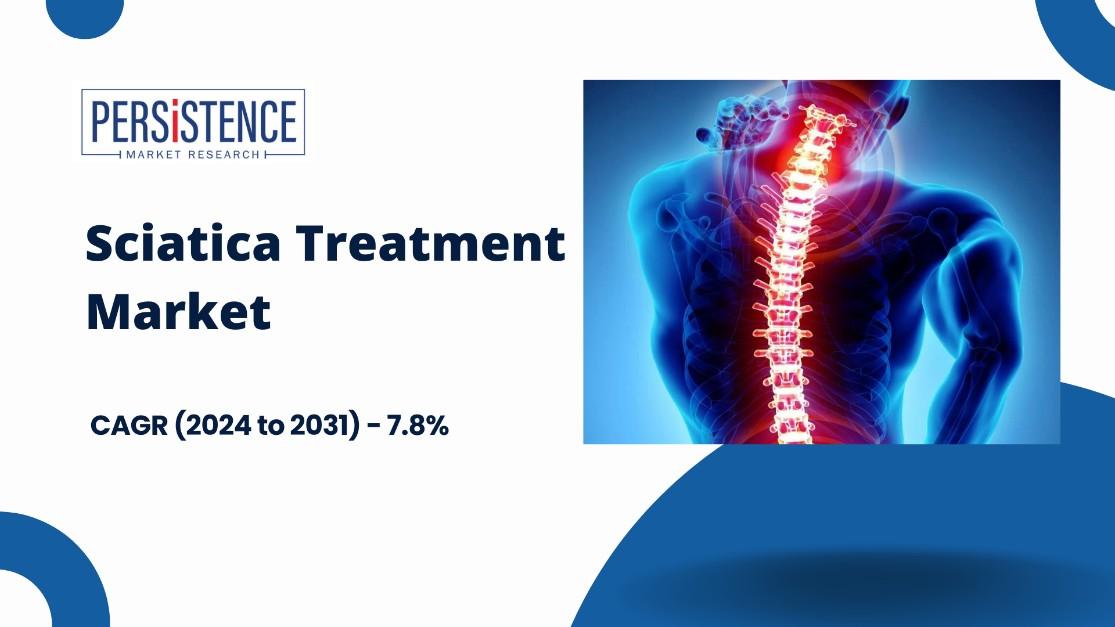Sciatica Treatment Market: Growth
Drivers and Restraints in Focus
The global sciatica treatment market is projected to grow significantly from USD 5.1 billion in 2024 to USD 8.6 billion by 2031, with a compound annual growth rate (CAGR) of 7.8% during the forecast period. Sciatica, characterized by pain radiating from the lower back down one leg, varies in intensity from mild to severe and can include symptoms like tingling and numbness.
Treatment typically involves a combination of methods such as physical therapy, alternative therapies (like yoga and chiropractic care), pain management, surgical intervention, and lifestyle modifications. Factors driving market growth include increasing global incidence of sciatica, an aging population, growing acceptance of non-invasive treatments, advancements in medical technology, and rising obesity rates leading to sedentary lifestyles and increased sciatica cases.
Moreover, healthcare expenditure growth and infrastructure development in emerging markets are improving access to sciatica treatment services. Key trends shaping the market include the adoption of alternative therapies, integration of digital health solutions, and increasing use of telemedicine and remote monitoring technologies.

Growth Drivers and Restraints in Focus
The sciatica treatment market is poised for significant growth, driven by various factors that promote market expansion, alongside challenges that pose potential constraints. Understanding these dynamics is crucial for stakeholders to navigate the market effectively. Here’s a detailed analysis of the growth drivers and restraints shaping the sciatica treatment market:
Growth Drivers
1. Increasing Prevalence of Sciatica
o Aging Population: As the global population ages, the incidence of conditions like herniated discs and spinal stenosis, leading causes of sciatica, is rising.
o Sedentary Lifestyles: Modern lifestyles characterized by prolonged sitting and lack of physical activity contribute to a higher prevalence of sciatica.
2. Technological Advancements in Treatment Options
o Minimally Invasive Surgeries: Innovations in minimally invasive techniques such as endoscopic discectomy and microdiscectomy reduce recovery times, minimize tissue damage, and lower complication rates.
o Spinal Cord Stimulation (SCS): Advanced SCS technologies offer effective pain relief by delivering electrical pulses to the spinal cord, managing chronic pain associated with sciatica.
3. Growing Demand for Non-Invasive and Alternative Treatments
o Regenerative Medicine: Therapies like stem cell therapy and platelet-rich plasma (PRP) injections offer promising alternatives by promoting tissue repair and reducing inflammation.
o Physical Therapy: Exercise therapy, manual therapy, and heat/cold therapy provide non-invasive approaches to manage sciatica symptoms and improve mobility.
4. Rising Healthcare Expenditure and Insurance Coverage
o Increased Healthcare Spending: Governments and private sectors are investing in healthcare infrastructure and advanced treatment options, enhancing accessibility to sciatica treatments.
o Insurance Reimbursement: Favorable insurance policies and reimbursement schemes for sciatica treatments encourage patient uptake of advanced therapies and surgeries.
5. Focus on Patient-Centric Care and Personalized Medicine
o Personalized Treatment Plans: Tailoring treatment approaches based on individual patient needs, genetic factors, and biomarkers improves treatment efficacy and patient outcomes.
o Patient Education and Awareness: Initiatives promoting early diagnosis, symptom management, and lifestyle modifications empower patients in managing sciatica effectively.
Restraints
1. High Cost of Advanced Treatments
o Surgical Procedures: Minimally invasive surgeries and advanced technologies for sciatica treatment can be costly, limiting access for patients in lower-income brackets or regions with limited healthcare resources.
o Regenerative Therapies: Stem cell therapy and PRP injections may incur high out-ofpocket expenses due to limited insurance coverage.
2. Potential Risks and Complications
o Surgical Risks: Despite advancements, surgical treatments for sciatica carry inherent risks such as infection, nerve damage, and complications related to anesthesia.
o Side Effects of Pharmacological Treatments: Long-term use of medications like opioids for pain management may lead to dependency, tolerance, and adverse effects.
3. Stringent Regulatory Approvals
o Regulatory Challenges: Obtaining approvals for new medical devices, therapies, and pharmaceuticals involves rigorous regulatory processes, delaying market entry and innovation adoption.
o Diverse Regulatory Standards: Varying regulatory standards across regions necessitate compliance strategies that can be complex and resource-intensive for market entrants.
4. Limited Awareness and Healthcare Infrastructure
o Underdiagnosis and Undertreatment: Lack of awareness about sciatica symptoms and treatment options in some regions leads to delays in diagnosis and inadequate management.
o Healthcare Disparities: Disparities in healthcare infrastructure and access to specialized care in rural or underserved areas hinder optimal treatment outcomes for sciatica patients.
5. Economic Constraints and Affordability Issues
o Economic Instability: Economic downturns and healthcare budget constraints in certain regions limit investments in sciatica treatment technologies and infrastructure.
o Affordability of Treatments: High out-of-pocket costs for advanced treatments may deter patients from seeking timely and effective care, compromising treatment adherence and outcomes.
Conclusion
The sciatica treatment market is propelled by factors such as the increasing prevalence of sciatica, technological advancements in treatment options, and rising healthcare expenditure. However, challenges such as high treatment costs, regulatory complexities, and economic constraints pose significant restraints. Addressing these challenges through innovation, collaboration, and strategic healthcare policies will be crucial for sustaining market growth and improving patient outcomes in the global sciatica treatment landscape. Stakeholders across the healthcare continuum must navigate these dynamics adeptly to enhance accessibility, affordability, and efficacy of sciatica treatments worldwide.
